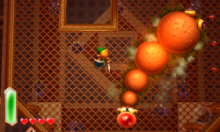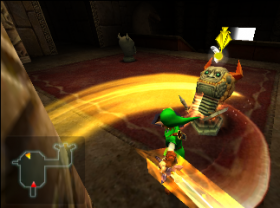A New Era for Top-Down Zelda Games?
Posted on April 20 2013 by Hanyou
 So top-down Zelda games are back. That should be encouraging news for all Zelda fans–they had an uncertain future, as the handheld market has changed dramatically since The Minish Cap graced the GBA.
So top-down Zelda games are back. That should be encouraging news for all Zelda fans–they had an uncertain future, as the handheld market has changed dramatically since The Minish Cap graced the GBA.
The Game Boy Advance and DS handhelds felt very much like spiritual successors Super Nintendo. At its outset, the Game Boy Advance offered a very traditional 16-bit RPG (Golden Sun, of course), a remastered Mario game, and a Mario Kart game that was regressive in the best way possible. Over the console’s life cycle, this all worked exceptionally well.
The DS sometimes functioned as a strange hybrid. That chapter opened with a Super Mario 64 remake, followed by a bunch of 2D and 3D games. It’s not clear quite where the Zelda games fell. They were clearly influenced most strongly by The Wind Waker, with small “islands” dotting massive overworlds, but most of the action was from a top-down view like traditional Zelda games. Their touch screen controls separated them even further from their console counterparts, 2D or 3D. That said, the DS also saw the rebirth of the 2D Mario game. People who dismiss New Super Mario Bros. games as mindless rehashes may forget that New Super Mario Bros. was widely praised in its day for being creative, fun, and well-designed, and bringing back a style of gameplay that had been sorely missed in the wake of the 3D Mario games.
 With the 3DS, we face the very real threat of the death of a dedicated platform for decade-old styles of gameplay. It can successfully mimick a console that was current-gen when the 3DS was released, and its very name implies a leap for handhelds. New Super Mario Bros. still exists, yes, but we also have our first brand new handheld 3D Mario platformer, which carries almost as much over from Super Mario Galaxy 2 as it does from traditional sidescrolling romps. Games like Tales of the Abyss, a fully 3D, voice-acted, popular RPG, and Starfox 64, which speaks for itself, have been ported over. Brand new games tend to be 3D.
With the 3DS, we face the very real threat of the death of a dedicated platform for decade-old styles of gameplay. It can successfully mimick a console that was current-gen when the 3DS was released, and its very name implies a leap for handhelds. New Super Mario Bros. still exists, yes, but we also have our first brand new handheld 3D Mario platformer, which carries almost as much over from Super Mario Galaxy 2 as it does from traditional sidescrolling romps. Games like Tales of the Abyss, a fully 3D, voice-acted, popular RPG, and Starfox 64, which speaks for itself, have been ported over. Brand new games tend to be 3D.
And of course, there’s Ocarina of Time 3D, which was universally praised and added a good deal to the experience of a game that seems best suited for a large screen. Naturally, its successor would be a 3D game built on the same engine, right?
Well, no. Nintendo’s announcement took me completely by surprise. I assumed that after The Minish Cap–a game that I loved–top-down Zelda games would, at best, be relegated to the odd state of limbo they found themselves in during the DS era. Instead, we have a game that borrows everything, from visuals to gameplay, from a much older era of games. Perhaps it will do the same thing for traditional-style Zelda games as New Super Mario Bros. did for traditional Mario games–or perhaps it will be even better, allaying the fears of those who worry about “rehashes.”
In any case, it makes for variety, and it helps provide incentive to buy a WiiU. After all, those of us who prefer the 3D games will have to buy Nintendo’s HD system to see what it has in store. Those who prefer more traditional styles still have a system they can run to. And with a pedigree like Link’s Awakening, the Oracle titles, and The Minish Cap, it would have been a shame to have let the handheld, isometric Zelda tradition disappear.
 I said at the beginning that these sorts of games had an uncertain future. Regardless of the fact that Nintendo has delivered plenty of 2D entries to series that have moved into 3D (See Mario, Metroid, Donkey Kong), I certainly felt that way prior to the announcement, and the feeling was justified: after all, in theory, there’s nothing you can do with a strictly 3D Zelda game that you can’t do with a top-down game. But of course, with a simpler control scheme and different methods of controlling your character comes an entirely different focus and feeling to gameplay. Some of the most innovative concepts have debuted in the traditional games. Link’s Awakening had a story focus that clearly helped pave the way for both Ocarina of Time and Majora’s Mask. The Oracle games might exist in a “bubble,” but being able to link them made the adventure feel huge. The Minish Cap introduced kinstones, one of the most addictive ideas yet seen in Zelda sidequests, and placed a focus on novel items that showed up in Skyward Sword. Those games have been good for the series as a whole.
I said at the beginning that these sorts of games had an uncertain future. Regardless of the fact that Nintendo has delivered plenty of 2D entries to series that have moved into 3D (See Mario, Metroid, Donkey Kong), I certainly felt that way prior to the announcement, and the feeling was justified: after all, in theory, there’s nothing you can do with a strictly 3D Zelda game that you can’t do with a top-down game. But of course, with a simpler control scheme and different methods of controlling your character comes an entirely different focus and feeling to gameplay. Some of the most innovative concepts have debuted in the traditional games. Link’s Awakening had a story focus that clearly helped pave the way for both Ocarina of Time and Majora’s Mask. The Oracle games might exist in a “bubble,” but being able to link them made the adventure feel huge. The Minish Cap introduced kinstones, one of the most addictive ideas yet seen in Zelda sidequests, and placed a focus on novel items that showed up in Skyward Sword. Those games have been good for the series as a whole.
Whatever this particular game holds in store, it represents the preservation of that proud tradition. If that ultimately leads to another game on par with Link’s Awakening or The Minish Cap, the Zelda community should embrace what the future holds.



